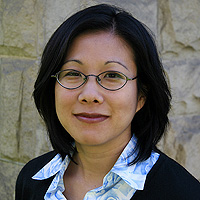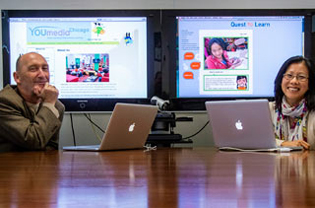Learning gets smart

Learning gets smart
- May 14, 2012
- Cultural anthropologist Mimi Ito believes the power of digital technology transcends the classroom and can be a stepping stone to future career success
 Today’s children and teens, who have been described as Generation I or “digital natives,”
were born after the Internet had become a staple in our lives. They grew up with Google,
Facebook, email and texting, not to mention digital cameras, online gaming and instant
connectivity, and they can’t comprehend of a world without computers.
Today’s children and teens, who have been described as Generation I or “digital natives,”
were born after the Internet had become a staple in our lives. They grew up with Google,
Facebook, email and texting, not to mention digital cameras, online gaming and instant
connectivity, and they can’t comprehend of a world without computers.
As they scroll through Facebook, watch YouTube videos or play “Words with Friends,” they’re probably not thinking about what they’re learning. But for UCI cultural anthropologist Mizuko (Mimi) Ito, these forms of new media, and the ways in which young people utilize them, provide a blueprint for designing new learning environments.
Ito believes new media and technology activities for children and teenagers ultimately can lead to improved academic and career prospects.
Her early work focused on understanding how kids learn in informal contexts, and now “we’re trying to take that and connect it to the kind of learning that matters for their future success,” she says.
Her research informed the design and implementation of a center that offers digital experiences to high school students. YOUmedia — a Digital Library Space for Teens, is headquartered in Chicago’s Harold Washington Library. Funded by the John D. and Catherine T. MacArthur Foundation, the 5,500-square-foot space is outfitted with computers, digital editing equipment, music keyboards, gaming consoles and video cameras, and is staffed by adult mentors who provide guidance and support. Forty thousand kids each year drop in to hang out with their friends and use the equipment.
Ito says even those who use the space exclusively to play video games or surf Facebook are benefiting. “They’re getting exposure to a range of opportunities and interests that they wouldn’t otherwise have exposure to,” she says.
But the kids who are more deeply immersed in the technology are producing “really amazing, creative things.” And because the program incorporates an online support mechanism, all the users can connect to their mentors even when they’re not physically in the space.
“It’s broadening access to an interest-based community and caring adults,” Ito says. “These mentors can frame those interests in ways that advocate for the young people in career pursuits or school or other places that really matter for future opportunity.”
Contact with technology is crucial for learning in today’s world, according to David Goldberg, director of the UC-wide Digital Media and Learning Research Hub located at UCI. “Increasingly we’re looking at a more robust mobile world enabled by technology, so learning happens anywhere, anytime, anyplace – pretty much all the time, even when one is not paying attention to [it],” he says.
Two studies conducted recently in India provide corroboration. School-age girls working in the fields, who were not formally schooled, were given cell phones embedded with English-language learning games. On their breaks, the girls played the games, picking up in the process language skills they would not otherwise have learned.
The second project placed screens connected to computers on the streets in publicly accessible areas. The screens displayed basic, elementary-level learning programs and games, and by attracting the attention of street-children who lived nearby, imbued a rudimentary level of schooling.
“The use of not-terribly-sophisticated technology is providing basic functional education to populations that don’t otherwise have access,” Goldberg says.
In more developed countries, interactive technologies are changing classroom methodology. In many schools, teachers no longer stand in front of the class lecturing about history, math or science. Instead, kids interact with mentors in online communities, scientific labs or corporate offices. They build multimedia presentations with classroom peers on mobile devices, communicate via Skype with soldiers in Iraq, blog, create spreadsheets and analyze data.
“While critically interpreting information was always important, it’s certainly much more important now,” says education professor Mark Warschauer, author of “Learning in the Cloud: How (and Why) to Transform Schools with Digital Media.”
Warschauer researched a middle school in Maine that he calls an outstanding example of how to incorporate new media in an experiential learning program. The school’s curriculum included 10-week interdisciplinary research projects on thematic issues, which were supported by laptops and online resources, digital cameras, camcorders and specialized software.
One project on the state’s civil rights movement incorporated interviews with civil rights leaders and research on original documents. It culminated in a 200-page book written by the students, which was available for download, as well as a five-part video that showcased their learning process.
“These are the kinds of things having access to the Internet can accomplish,” Warschauer says. “Could you do that without technology? Possibly. But you could do it 20 times easier with it.”
He cautions, however, that technology is no better than the strength of the program that incorporates it. “You don’t solve a problem just by throwing computers at it. Integrating technology into any kind of social system is not just an engineering issue; it is a human and social issue. It takes good pedagogy, good assessment and good curriculum. And all these things take a lot of time and effort.”
One school in New York City seems to have achieved this ideal. Called Quest to Learn, it brands itself as “a school for digital kids… a community where students learn to see the world as composed of many different kinds of systems.”
Funded in part by the MacArthur Foundation, it utilizes online interactivity and peer-based gameplay in its curriculum, as well as a highly collaborative approach to problem-solving.
And its students fare better in standardized testing than the mean average in the city’s schools.
Most schools are not quite as digitally progressive yet, but Warschauer believes adopting technology across the board is essential in our information economy. “There’s no adult in the world who’s involved in knowledge production who doesn’t make use of digital media to find and analyze information, interact with people, and write and edit. So I think it’s safe to assume if we’re serious about learning how to gather, interpret and produce knowledge, it needs to be a part of schools as well.”
The trend appears to be gaining traction. The ratio of computers to students in schools is about 3:1 now, down from 14:1 two decades ago. Warschauer predicts that in 20 years, 95 percent of all schools will have a digital device for every student. “It’s not going to be so much a question of how we afford to do it but how can we afford not to?” he muses.
When technology is incorporated into classrooms, it changes the teachers’ roles. “The teacher has to become something other than an expert,” Goldberg says. “He/she has to become more of a facilitator, a kind of conductor.”
Informatics assistant professor Gillian Hayes works with teachers to design classroom management tools and advocates for teacher involvement in technology research and design. “If you don’t teach the teachers how to use these technologies and we’re not designing them with teaching in mind, then we’re not going to accomplish anything.”
One of Hayes’ doctoral students, Meg Cramer, collaborated with teachers to create “Reflect with Me.” The tablet-based tool allows groups of students in digitally connected workspaces to create multimedia collections and pass elements of those collections to each other or to other groups. Hayes calls it a “mash-up” model. The teacher can monitor the groups’ progress from her tablet, and both teacher and students can “rewind” the experience to see how it was accomplished. The system also allows the students to see who has “borrowed” pieces of their presentation and to learn the importance of proper attribution.
“Getting credit for what they’ve produced is really important,” Hayes says, and empowers them to continue creating. “It’s not unlike the sort of high that adults get from their Wikipedia articles being read.”
As is often the case, new technology can create resistance. “Throughout history, every time a new technology comes in place there’s always this sort of dual reaction,” says Hayes. “A portion of the population believes this new thing will completely revolutionize education and another portion says it will be a disaster.”
The trend, she says, began with slates in the classroom and extended through the inclusion of television, computers and now, mobile devices, in education.
“Technology itself is not transforming education but we’re starting to see that different
kinds of pedagogical approaches can be enhanced with technology,” says Hayes. “If
you’re a teacher who believes in hands-on learning and you can’t go out to the ocean
because you live in Iowa, you can use technology to simulate the ocean and run experiments.”
Experts generally agree that the next big shift in the technology landscape will
be the imminent explosion of smart mobile devices.
In education, mobile technology facilitates the life-as-a-lab approach by accompanying students into their environments, whether it’s a biology field trip, a visit to the museum or just a night at home.
“It’s unrealistic that we expect students to learn from these technologies during the school day and not take them home at night. It’s not how people learn,” says Hayes.
And the constant connectivity afforded to young learners when inexpensive, smart mobile devices give them access 24/7? “It’s going to be a game-changer,” says Ito. “It’s really going to change what we think of as knowledge and information environments.”
-Anna Lynn Spitzer, calit2 communications
-pictured: Goldberg and Ito, courtesy of Paul Kennedy
Share on:




connect with us